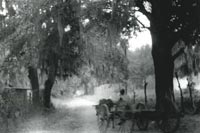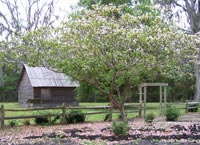-

- 19th century plantation scene
-

- Slave cabin and Tung tree
African American History
In the 19th century when LeConte-Woodmanston was the largest plantation in St. John's Parish (now Liberty County), 231 African Americans were enslaved there.
In the early days everything necessary for daily life was done on the plantation. African Americans were tanners, shoemakers, blacksmiths, carpenters and masons. They also participated in hunting, gardening, caring for the house and children and guarding the plantation.
The purpose of the plantation was growing rice for profit. This involved clearing the land, building dams and dikes, planting, harvesting and preparing the product for shipment and delivery. The creation of this plantation was a very arduous task. This work, all done by African Americans, required not only the knowledge of agricultural practices but engineering, organizational and management skills. Many of those enslaved were descendants of individuals who came from western African regions where rice was cultivated. They brought and contributed their rice cultivation knowledge and skills to this plantation and others in the area. It was their knowledge and work that made Woodmanston, and other 18th and 19th century plantations, successful.
The cultivation of rice required hard work in unhealthy environments. Wealthy planters and their families often left for summer retreats to avoid high temperatures and diseases like malaria. Management of the plantation was then left to a white or an African American overseer and the remaining enslaved individuals.
Those enslaved on the plantation changed their name to LeCounte following their release from bondage. A LeCounte family tree can be found at LeCounte Park in Liberty County.
As a part of our focus on African American history at LeConte-Woodmanston and in Liberty County, we are part of The Flood Gate Narrative oral history project which began in September 2009. We are partnering with Dorchester Academy and SCAD to complete this important project.
Descendants of those enslaved at LeConte-Woodmanston remain actively involved in preserving the history of their ancestors. For example, they were responsible for completing the restoration of the slave cabin on our grounds in 2003. A reunion of descendants is held at LeConte-Woodmanston every two years.
According to a representative of the Historic Preservation Division of the DNR in Atlanta, LeConte-Woodmanston will be part of the National Park Service's Gullah-Geechee National Corridor.